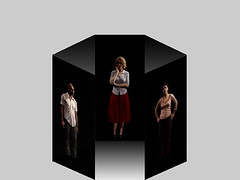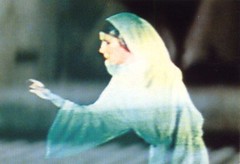Ideas and Process for In the House of Shouters
My new work 'In the House of Shouters' came from thinking about a few different ideas, not only how the spaces between people affect communication but more specifically the desire people have to make connections with other people but how so often people seem to constantly talk about themselves and not really listen to others. I though interactive aproxymate characters could be the perfect entities for representing this kind of dialogue between a talking but un-listening character.
I started thinking about the online dating phenomenon. I discovered that you often have to fill in a personality test before you can join many of these online dating services – supposedly to find out what kind of person you are so others can relate to you. I started collecting the tests.
Most of the tests consist of a series of questions followed by 2 – 3 choices of prescribed answers. I became really interested in how people might use these test answers to describe themselves and I thought id to make a work where the characters only used only words from these tests.
Writing the script I chose phrases that I assumed might signify that you were almost unable to communicate with others at all - and re-wrote a kind of neurotic self-centred dialogue for the three characters. I created the original script as a hypertext script – so it was written to work in both linear and non-linear modalities. Cut up technique
This work was partially created during a Residency at The Performance Space – where I spent three weeks writing, rehearsing and doing the video shoot. At the Performance space I held a series of workshops with my three performers Brian Fuata, Julie Vulcan, Karen Therese - where the open and re-orderable, re-linkable script I had written was further developed with their collaboration. A spoken and unspoken and language and was created by each performer for each character. Through this collaborative process a new script was constructed, also leaving space for improvisational elements to evolve in the video shooting process. The video shooting process involved working from a timeline (developed in the workshops) of words, phrases and gestures to record for each individual character and particular moments of connection / disconnection between the various characters.
Editing and designing the interaction.
After the residency came the editing. This is the longest most time consuming process. And strange because you I was working in a linear way editing but imagining or simulating how it might turn out in a non-linear situation.
I wanted to create 3 separate video characters that were also interrelated. I wanted the video streams or video characters to make sense when played in a linear order but also be divided into segments that would make sense when the videos were recombined in many different orders. I wanted a viewer to be able to interact with the characters separately and also as a group.
As part of the editing process I designed an interactive dramaturgy that involved 1 viewer, the 3 video characters and an environment with 5 different interactive zones. These zones were based around notions of social distances in face-to-face communication – particularly looking at cultural anthropologist Edward T Hall’s notion of "proxemics," or how peoples use of space particularly bodily positions in group situations affects communication
Implementing the interaction design in collaboration with Volker Kuchelmeister
So there are various ways this could be done. My initial plan was to create a DVD installation – using chapter markers as the re-orderable points in the video streams. This approach which has been used in quite a few interactive installations requires multiple industrial DVD decks and a specially built and programmed micro-controller - in essence a miniature computer used to control the synchronization of the various DVD players and that can be hooked up to the interface (sensors etc) and alert them when to play particular chapter points. Some of the drawbacks of this approach are that it is expensive and requires the expertise of someone who can build this type of micro-controller. I was in the midst of working on such a DVD system when I discovered Volker Kuchelmeister and Brad Miller had begun research and development in to the creation of a flexible interactive framework that would allow artists to stage different screen based interactive ideas without using much hardware and without requiring much new software development for each project. I asked to participate in their initial R&D period at Artspace where we tested an earlier work of mine using their basic framework This worked well so when I had finished the initial stages of in the house of shouters I approached Volker again to. Since then Volker has become one of my PhD supervisors.
I started thinking about the online dating phenomenon. I discovered that you often have to fill in a personality test before you can join many of these online dating services – supposedly to find out what kind of person you are so others can relate to you. I started collecting the tests.
Most of the tests consist of a series of questions followed by 2 – 3 choices of prescribed answers. I became really interested in how people might use these test answers to describe themselves and I thought id to make a work where the characters only used only words from these tests.
Writing the script I chose phrases that I assumed might signify that you were almost unable to communicate with others at all - and re-wrote a kind of neurotic self-centred dialogue for the three characters. I created the original script as a hypertext script – so it was written to work in both linear and non-linear modalities. Cut up technique
This work was partially created during a Residency at The Performance Space – where I spent three weeks writing, rehearsing and doing the video shoot. At the Performance space I held a series of workshops with my three performers Brian Fuata, Julie Vulcan, Karen Therese - where the open and re-orderable, re-linkable script I had written was further developed with their collaboration. A spoken and unspoken and language and was created by each performer for each character. Through this collaborative process a new script was constructed, also leaving space for improvisational elements to evolve in the video shooting process. The video shooting process involved working from a timeline (developed in the workshops) of words, phrases and gestures to record for each individual character and particular moments of connection / disconnection between the various characters.
Editing and designing the interaction.
After the residency came the editing. This is the longest most time consuming process. And strange because you I was working in a linear way editing but imagining or simulating how it might turn out in a non-linear situation.
I wanted to create 3 separate video characters that were also interrelated. I wanted the video streams or video characters to make sense when played in a linear order but also be divided into segments that would make sense when the videos were recombined in many different orders. I wanted a viewer to be able to interact with the characters separately and also as a group.
As part of the editing process I designed an interactive dramaturgy that involved 1 viewer, the 3 video characters and an environment with 5 different interactive zones. These zones were based around notions of social distances in face-to-face communication – particularly looking at cultural anthropologist Edward T Hall’s notion of "proxemics," or how peoples use of space particularly bodily positions in group situations affects communication
Implementing the interaction design in collaboration with Volker Kuchelmeister
So there are various ways this could be done. My initial plan was to create a DVD installation – using chapter markers as the re-orderable points in the video streams. This approach which has been used in quite a few interactive installations requires multiple industrial DVD decks and a specially built and programmed micro-controller - in essence a miniature computer used to control the synchronization of the various DVD players and that can be hooked up to the interface (sensors etc) and alert them when to play particular chapter points. Some of the drawbacks of this approach are that it is expensive and requires the expertise of someone who can build this type of micro-controller. I was in the midst of working on such a DVD system when I discovered Volker Kuchelmeister and Brad Miller had begun research and development in to the creation of a flexible interactive framework that would allow artists to stage different screen based interactive ideas without using much hardware and without requiring much new software development for each project. I asked to participate in their initial R&D period at Artspace where we tested an earlier work of mine using their basic framework This worked well so when I had finished the initial stages of in the house of shouters I approached Volker again to. Since then Volker has become one of my PhD supervisors.



